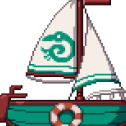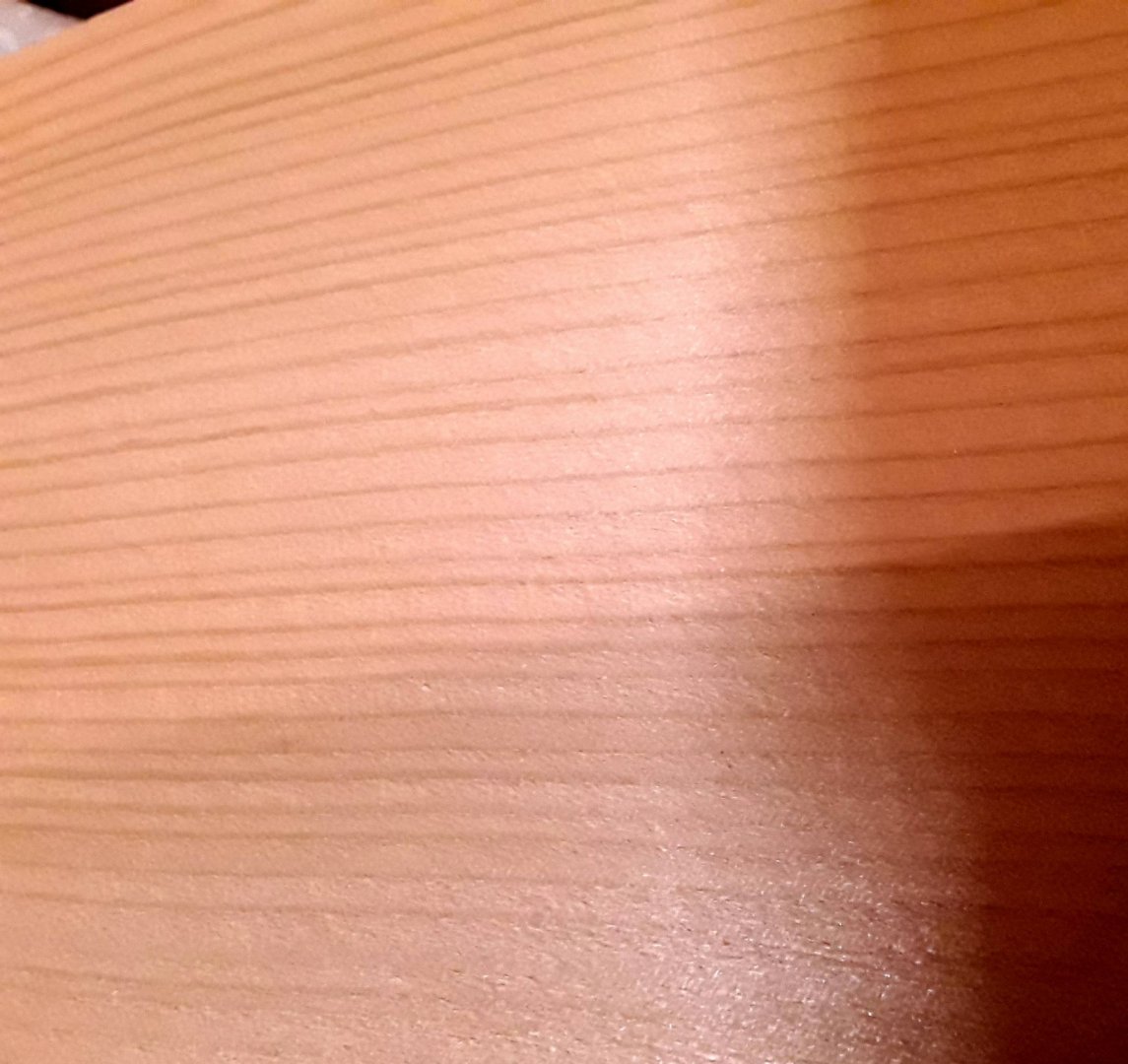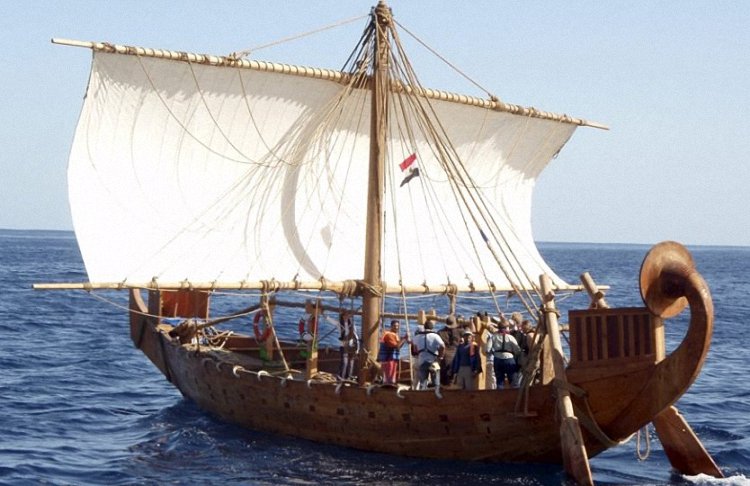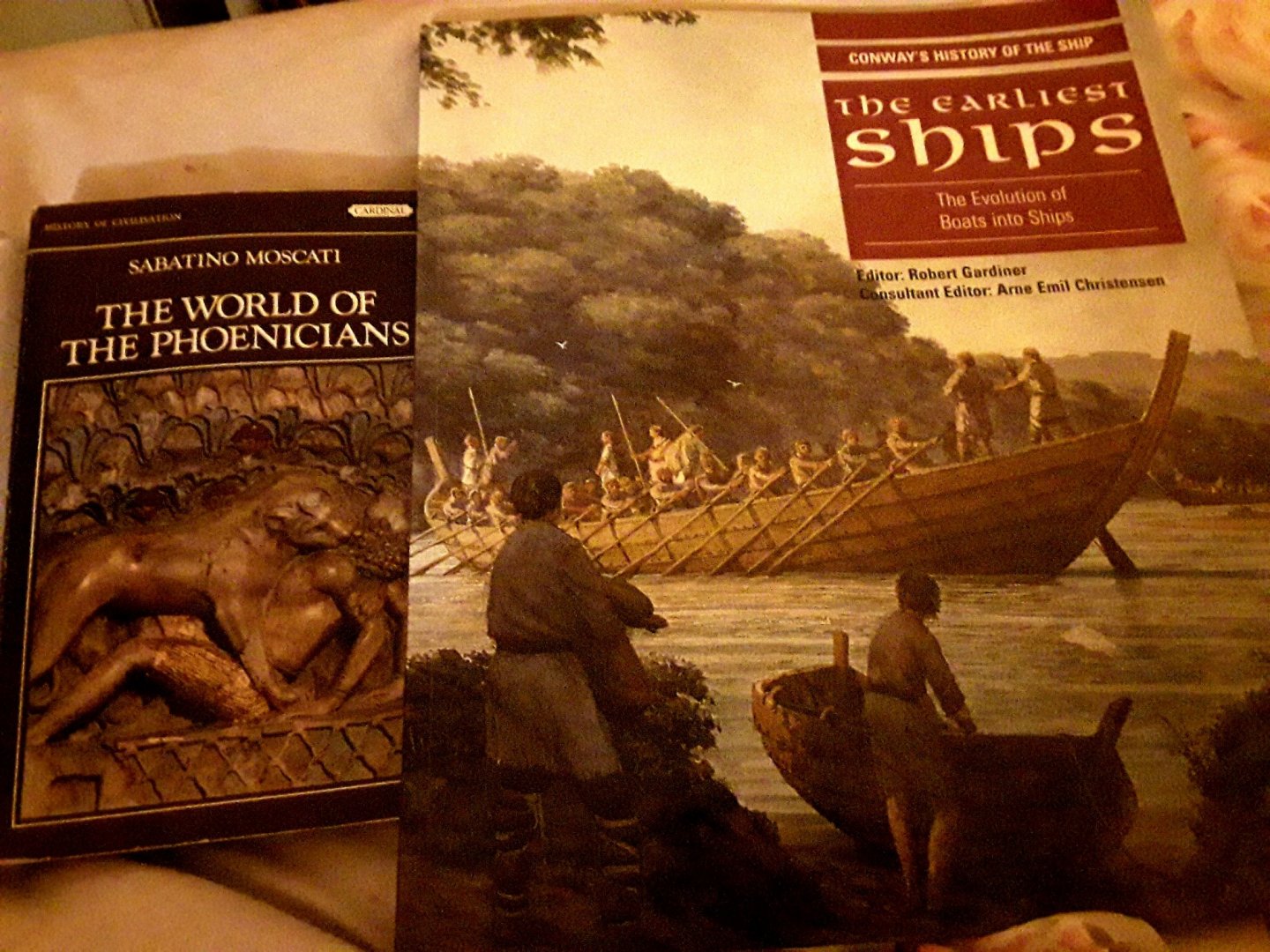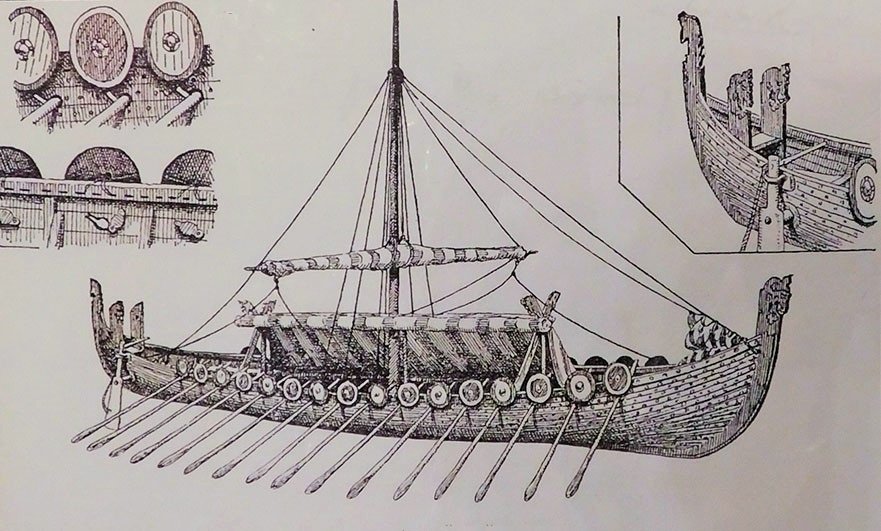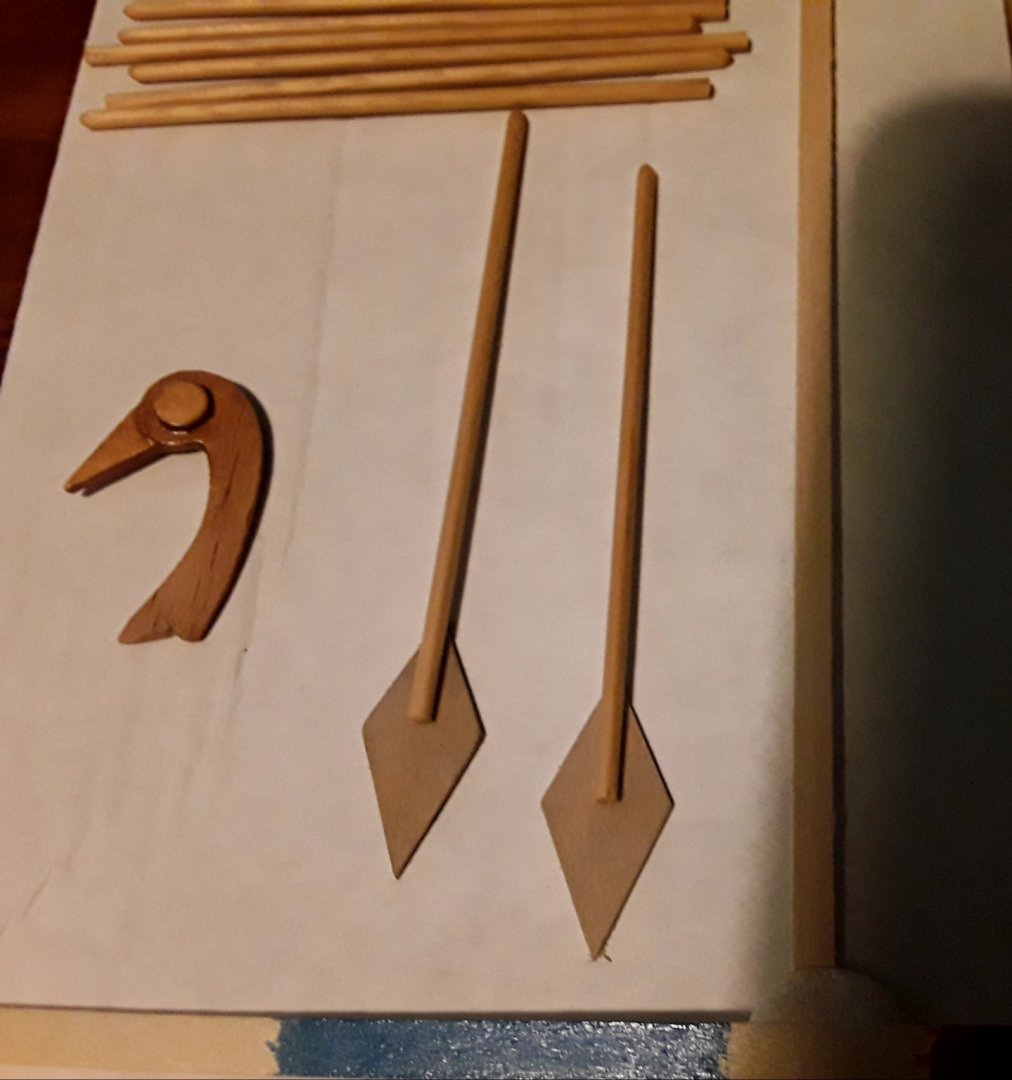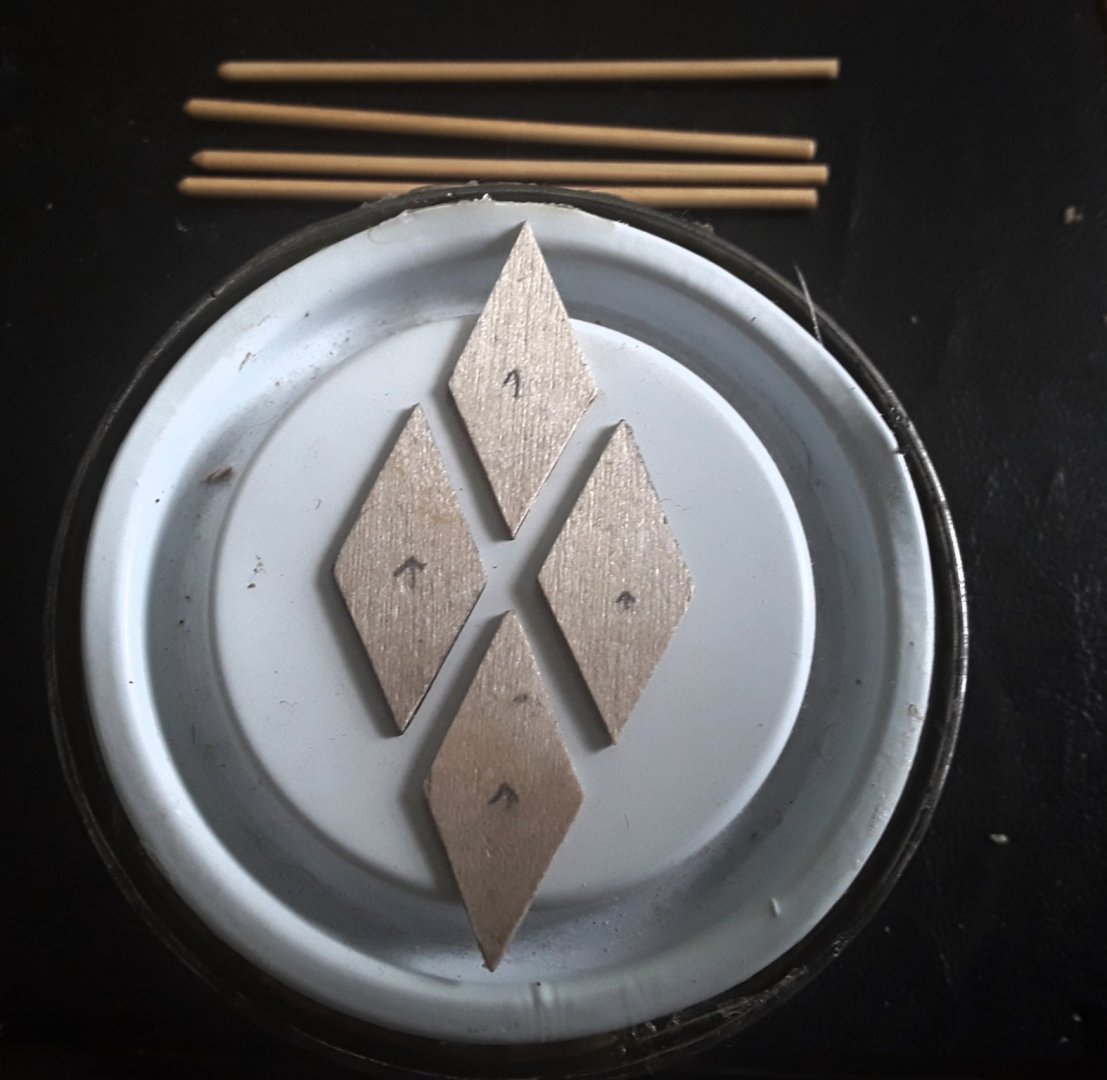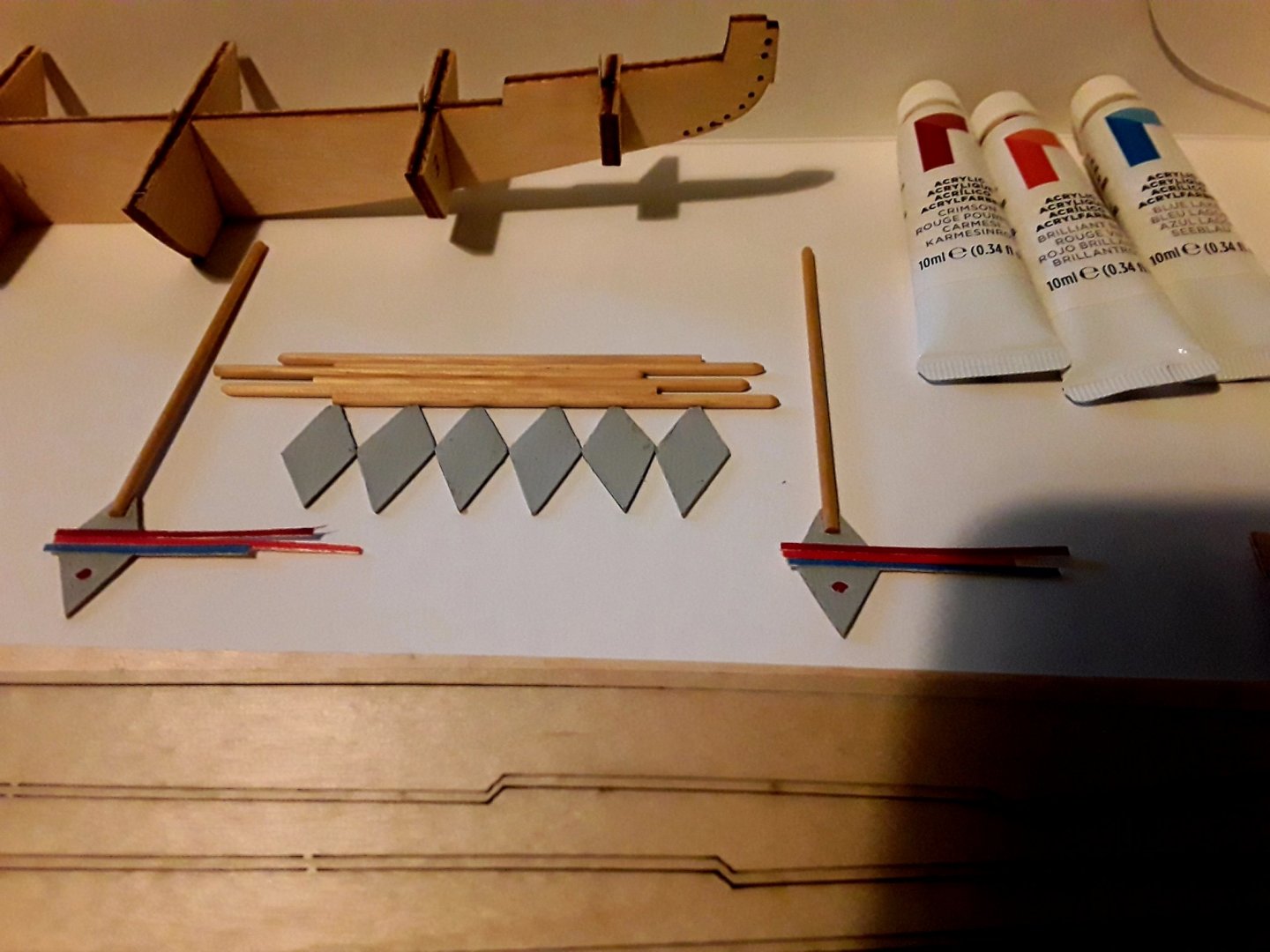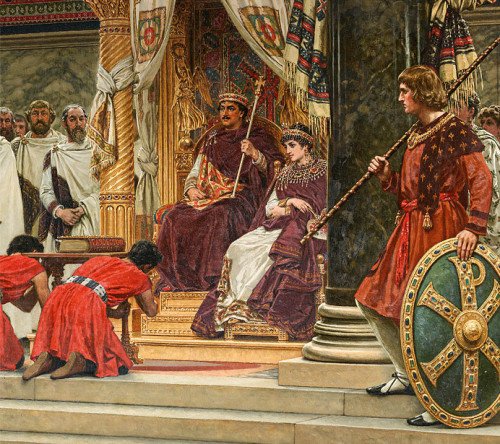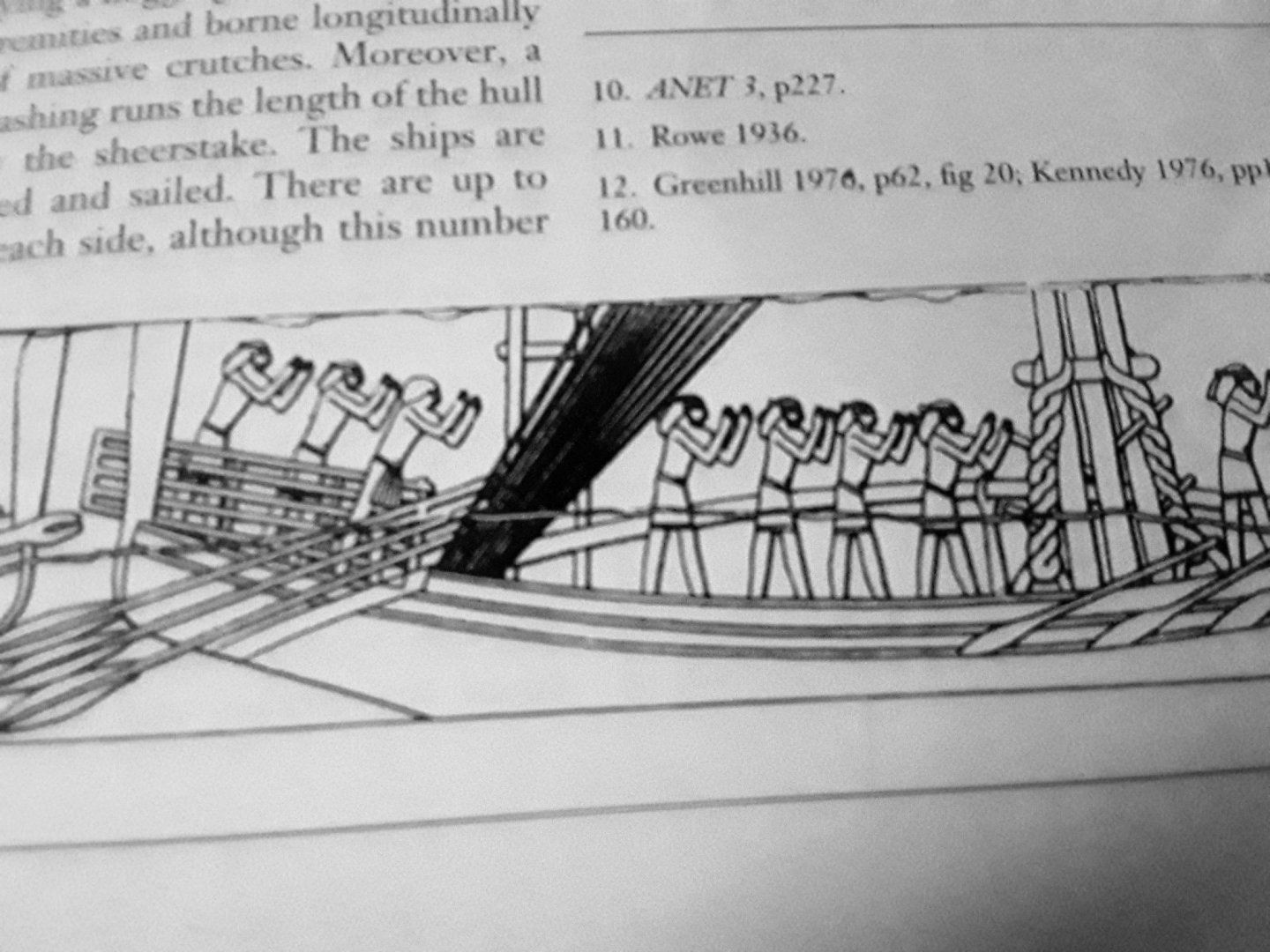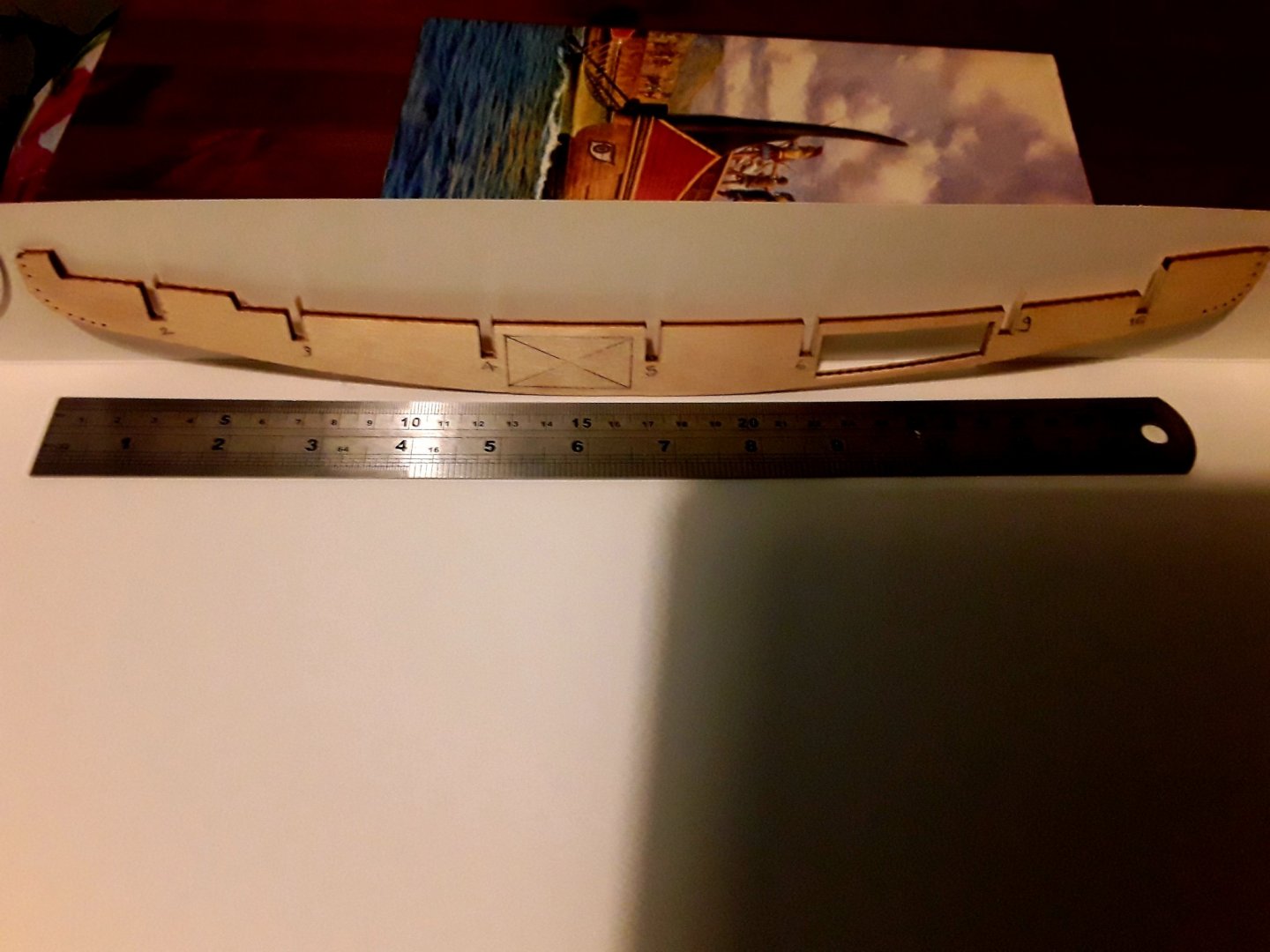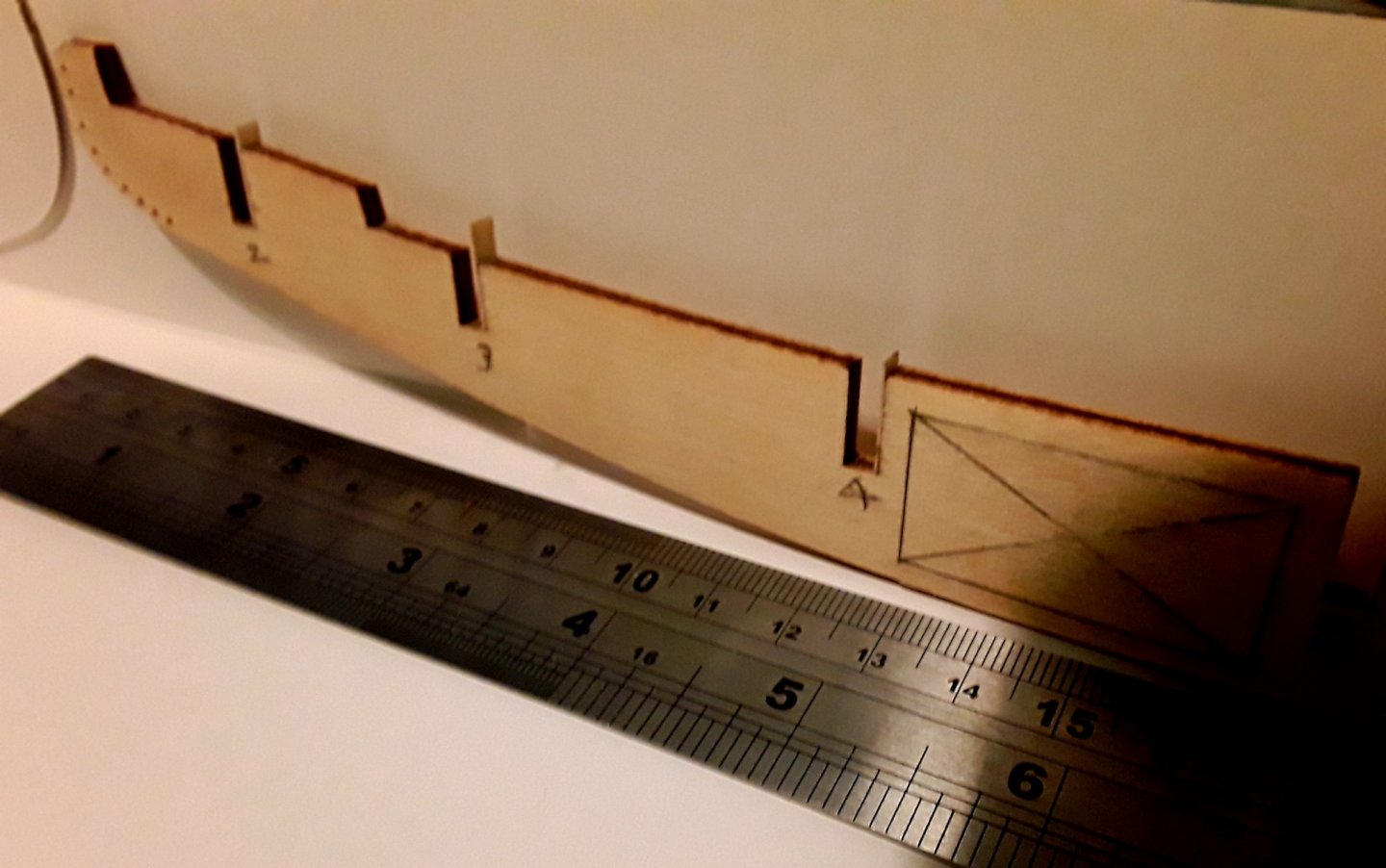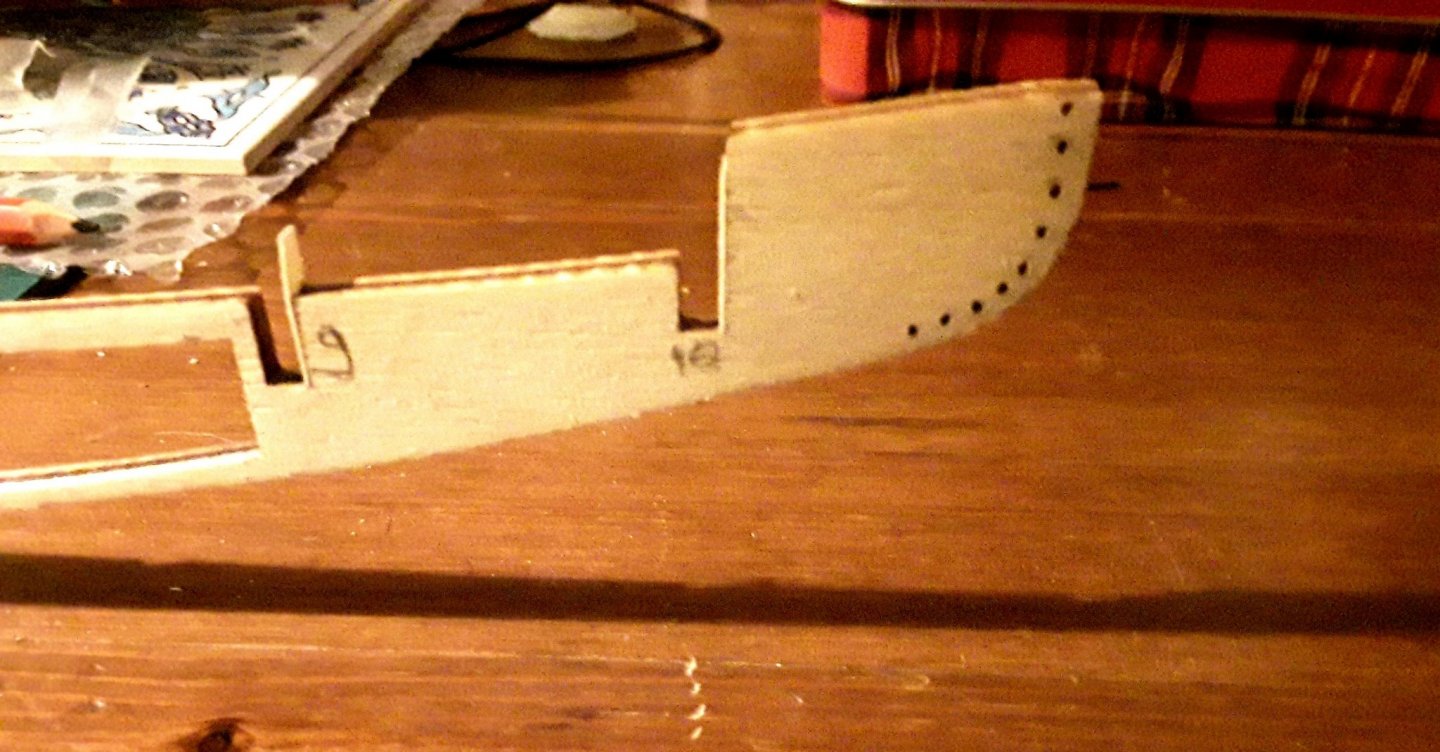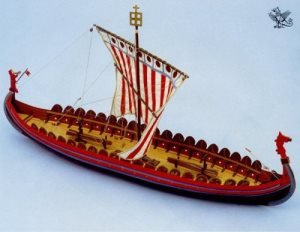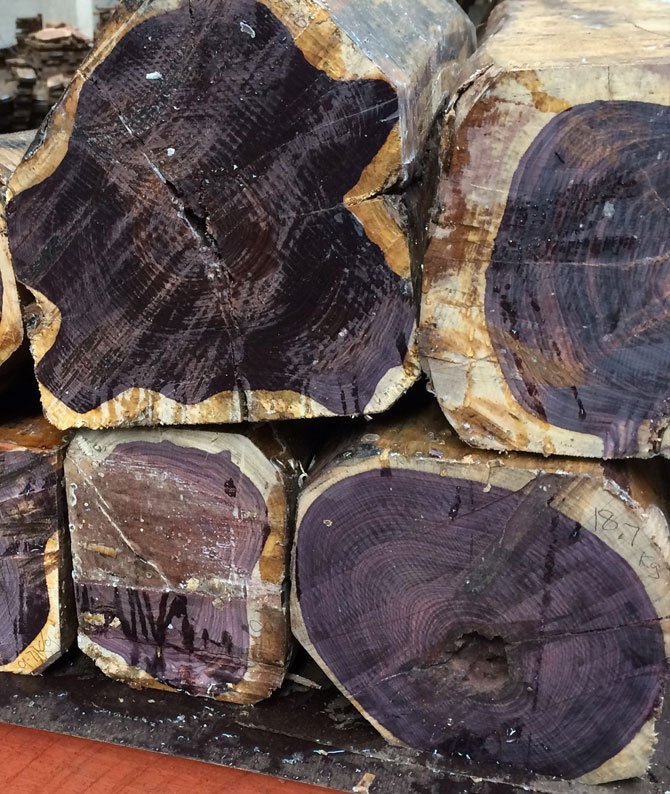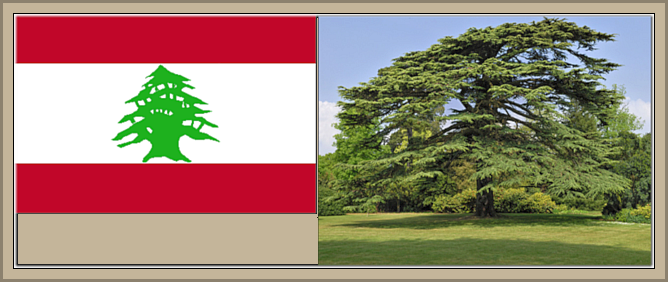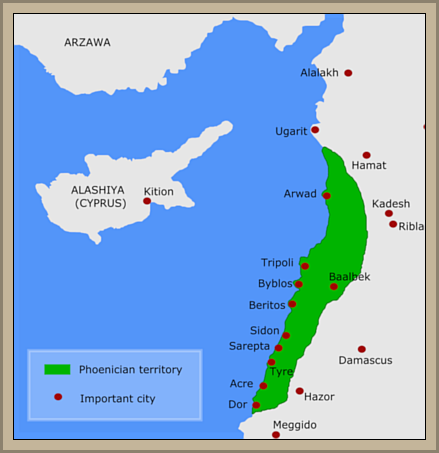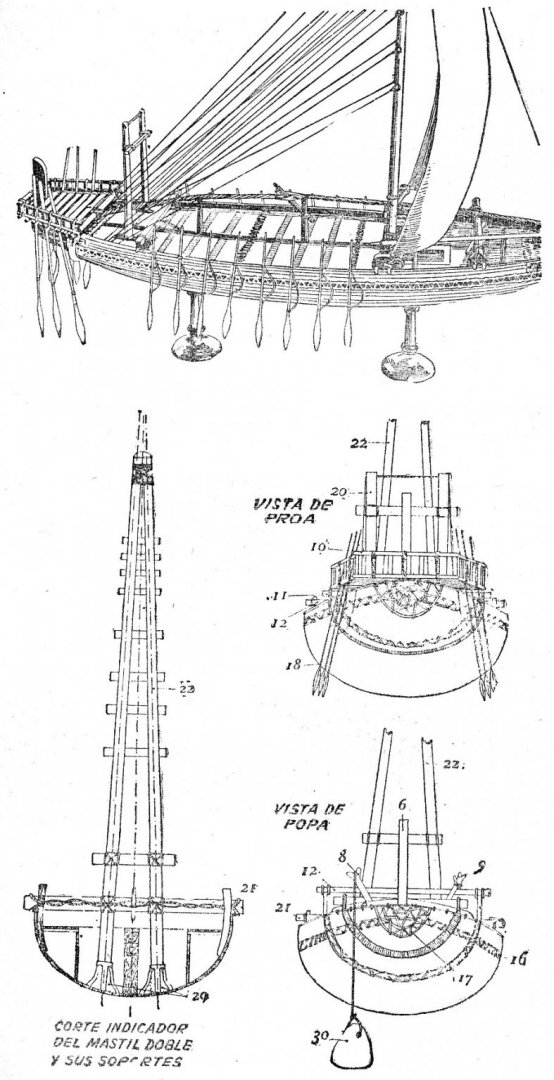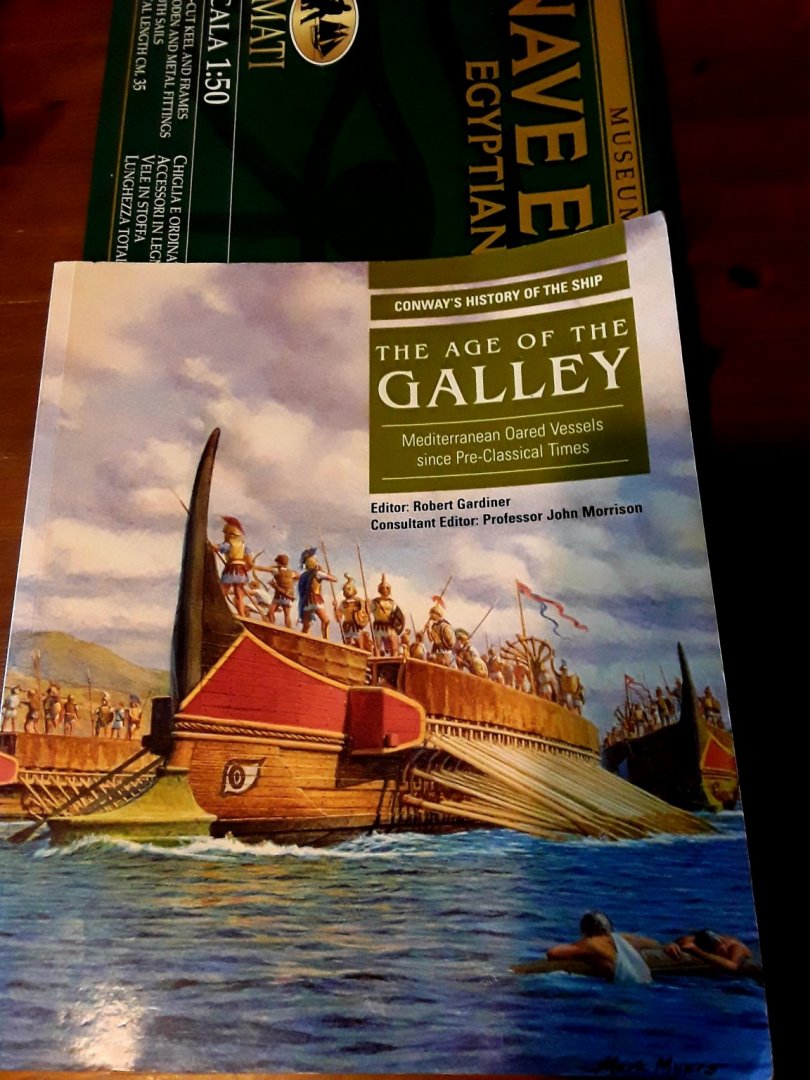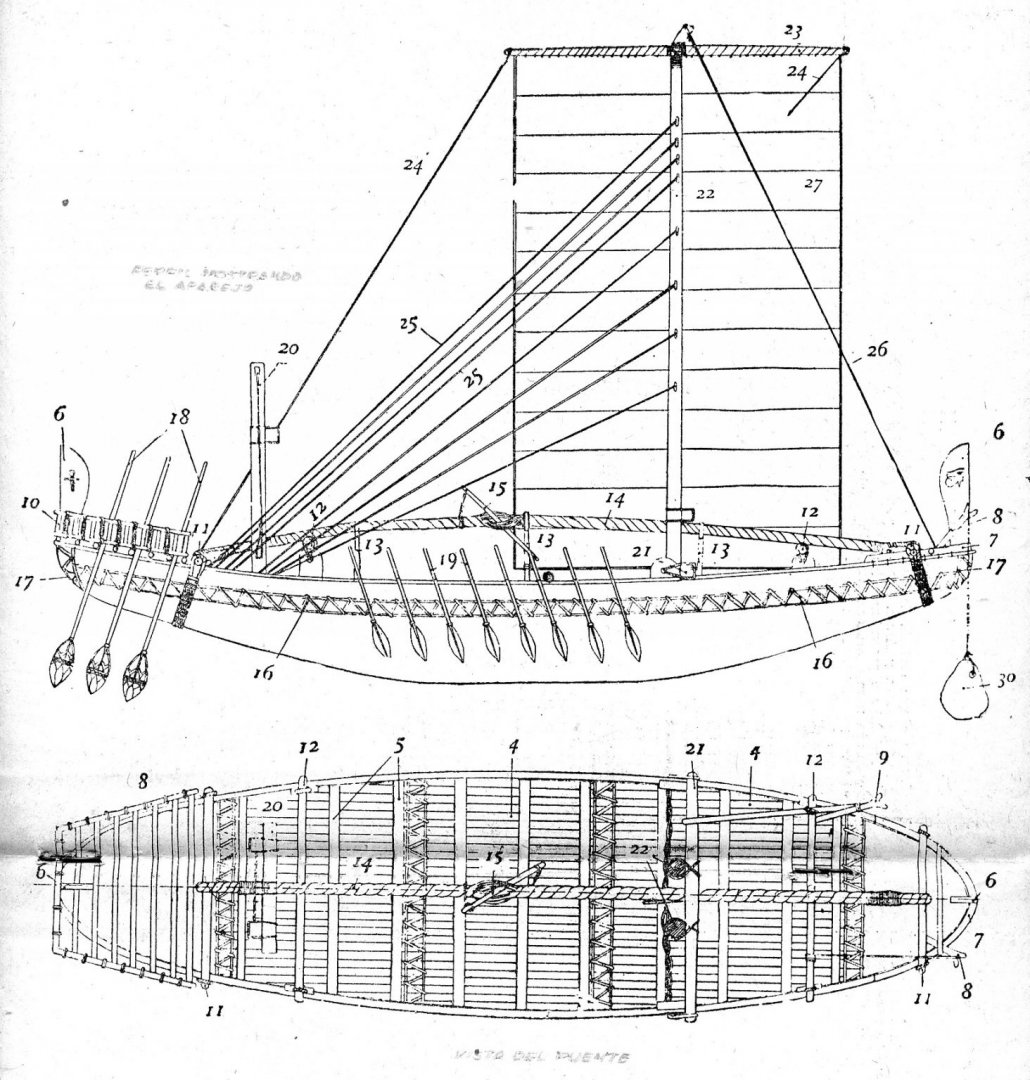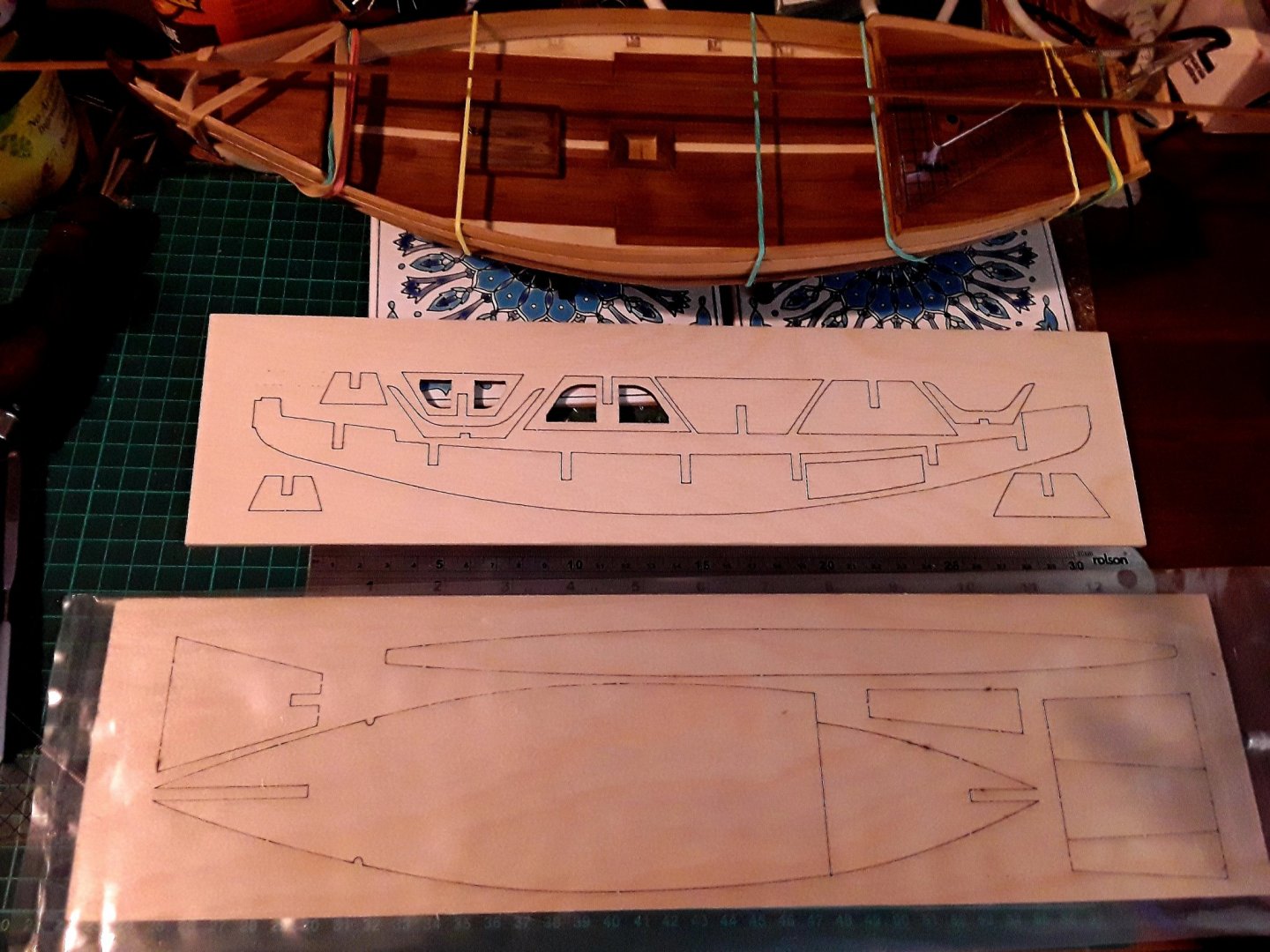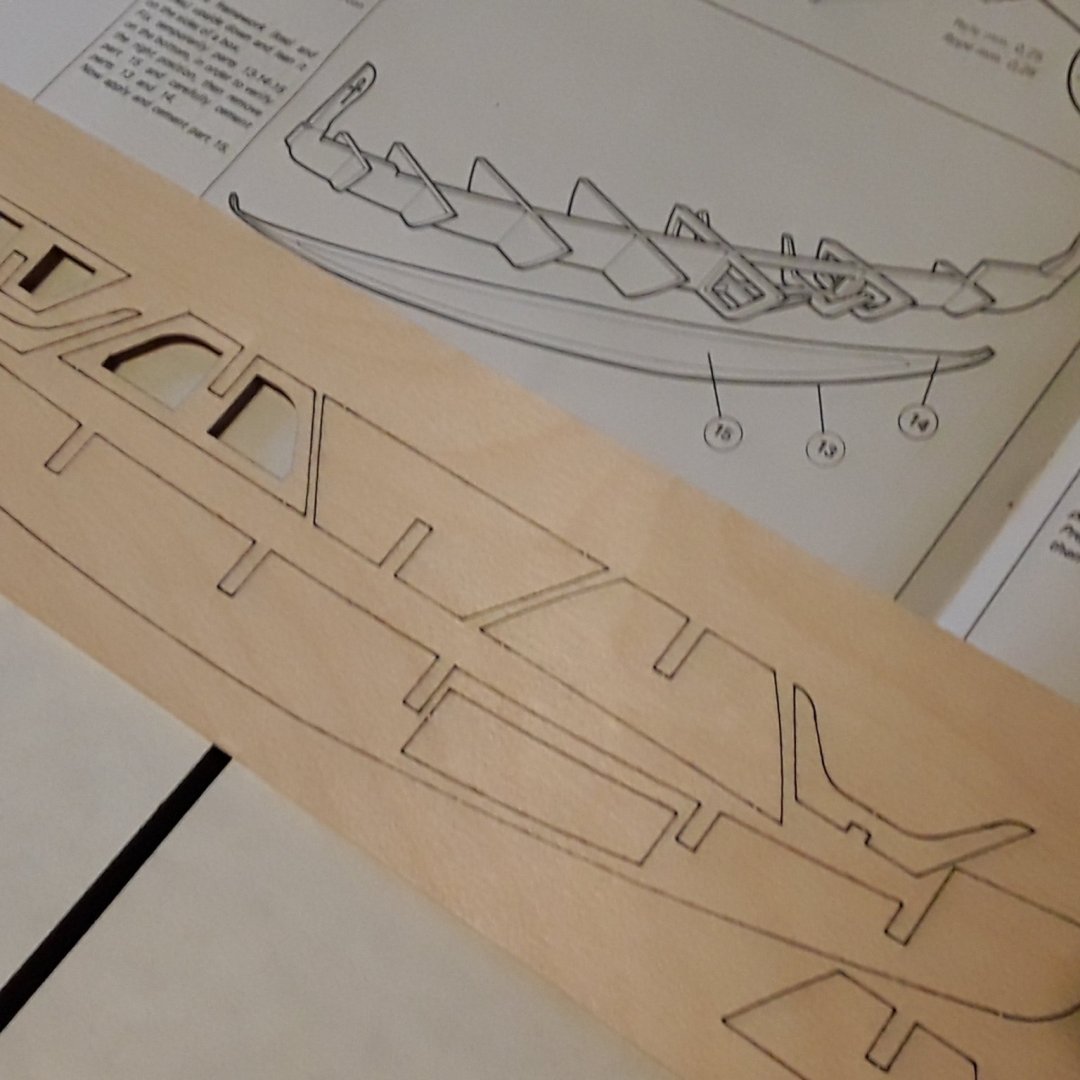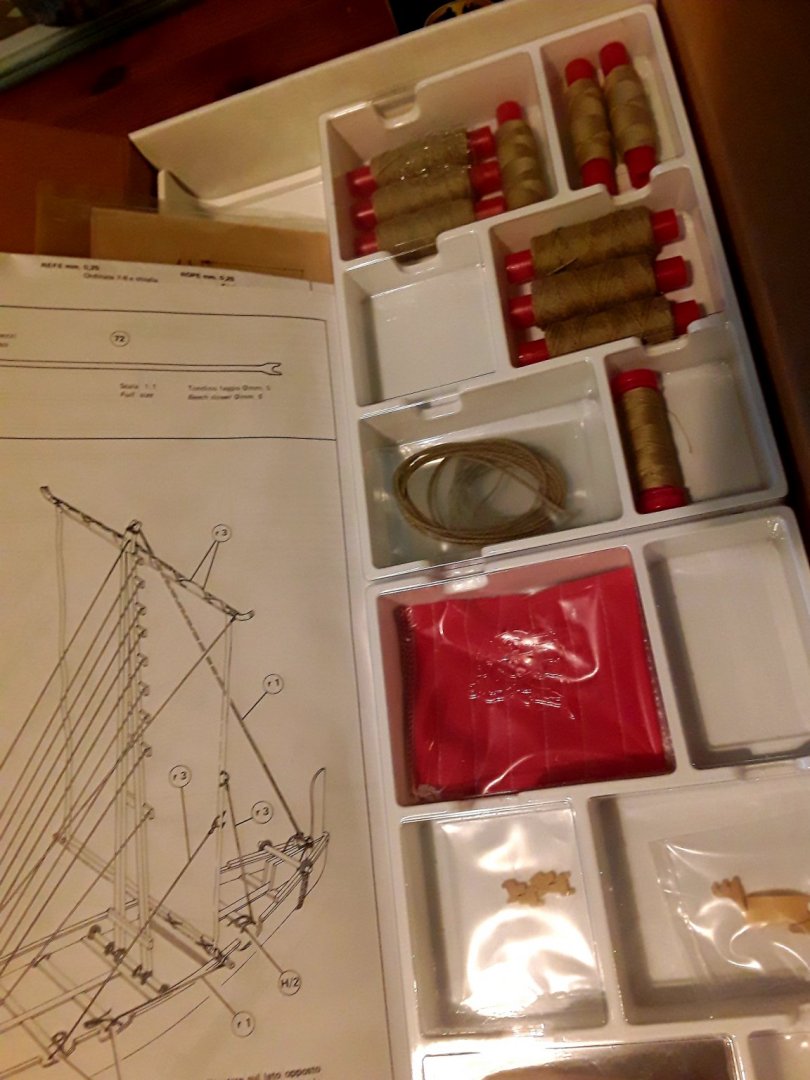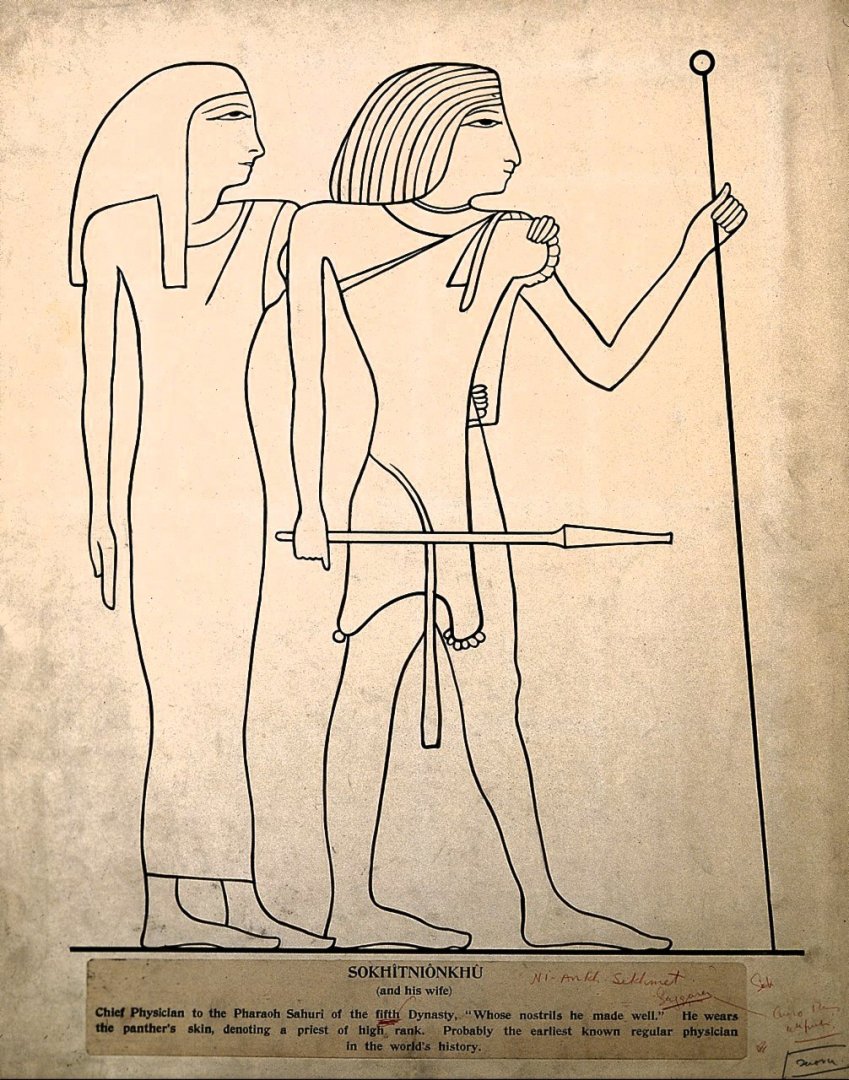-
Posts
131 -
Joined
-
Last visited
Content Type
Profiles
Forums
Gallery
Events
Everything posted by Nikiforos
-
If you succumb (and you ought!) be aware that DD now uses walnut for his pentekontor. Previously, he offered alder. This means an inherently darker wood in an entirety, so that typically nice orange stain that looks about perfect for alder (search for Robin Lous' build) is now no longer possible unless jiggerypokery. Also ditch the 2 mm hull planking, use 1.5mm at best; that's an evil stern curve she has. Oh and epoxy for the plywood, it's as porous as venetian glass. I'll hush now : ) Looking forward to see how this progresses.
-
Well then. A demonstration of what makes this forum -and especially its members- such a gold mine. Not merely sawdust but gold dust, as it were. Stephen thank you for the assist; I've an extra thought about this fascinating image which in brief is arguably about captivity AND/OR religious practice. One of them has no relevancy, the other does, but another red herring is of course possible. The figures on deck aren't celebrating The Bangles reaching No. 1 with "Walk like an Egyptian", they're captive slaves. Will write more about your learned observations when feeling less wretched but suffice to say, I'm accepting your interpretation of a short stumpy middle strengethener and will model it in. It j7st makes simple, sound, sense. Oh and my 8 feet of Lebanese Cedar veneer arrived. Sorting it slowly into 'scale' strip and 'overscale' strip; either of <4mm and 'looks silly'. The kit plywood to be traced directly onto homogenous parts of the veneer where appropriate. What is odd is that tilia plywood forms the actual visible hull exterior. I think Amati wants us to stain it, but we can do better. By the way, 8 feet isnt that much when you consider my dhow took 8 metres of Niove wood (4mm width but including wastage and another gorgeous wood species) to finish its decking. (Good Lord..). Thank you Stephen, his heron and those who offer upvotes and support. Later! Cedrus libani. Smells fantastic too.
- 45 replies
-
- egyptian
- bronze age
-
(and 1 more)
Tagged with:
-
Down and out for a little bit due to 'big C' -related stuff but I have time for a couple of questions to pose for those who understand the structure of -any- seagoing small vessel similar in size and manouverability as Byblos-ship. Questions: Why would -any- ship require a tripodal mast? Is it needed to support more weight, perhaps in a transition to the more horizontal heavier wider sail we observe in the later egyptian boats (load bearing enough to include limited human travel across the yards)? (we cannot see much from this small image -the remainder of it in Conway's yields no clues). Such a technological leap forward here seems doubtful -we're talking about the very early Dynasties -i.e. Pharaoh Sahure. Perhaps extra support because of weather/seaworthiness issues? Feeling beyond puzzled about this whole tripod thingy honestly! How would this arrangement look compared to the standard bipodal drawn plans, as it ascends towards the mast head? Lastly, I see tensioning bars at the lower mast in the grapevine heavy rope affair, exactly as per a hypozoma. What would tensioning bars be doing exactly at that location? And why is only the lower mast to be tensioned as the hemp doubles back on itself exactly there? Thank you, if anyone has any ideas or proposals. Part of Amati's illustrations (for discussion purposes only!) showing how a bipodal mast operates in the original kit. Quack. (Do herons quack?)
- 45 replies
-
- egyptian
- bronze age
-
(and 1 more)
Tagged with:
-
Like the rest in the series, various authors write about their specialisation but collaboratively. From memory (lol), as it's all of one storey above me in Castle Nikiforos (sort of bedridden for a bit) - neolithic types, egyptian, minoan, phoenician, iron age, a nice section on chinese Dragon boats and then northern European development right up your street. This book is actually quite cheap 2nd hand at ama*on co uk exactly now, but you've postage to pay of course. On balance its a title probably more for you than I, but my Lord, such excellence all in one place. A superb series. Edit: Its -definitely one for binho; 'celtic' and 'north european' boats seem to fill a lot of pages but a nice dhow section as well : ) O/ Best wishes,
- 45 replies
-
- egyptian
- bronze age
-
(and 1 more)
Tagged with:
-
RickyGene -a stunning Sardinian-Piedmontese Xebec model got me into boats after years of other subject matter. I for one would love to see a build log, if you could spare the time. Best wishes,
-
Thanks again! The poor old Mora seems to have surrounded herself with misrepresentation. And agreed, Daniel Dusek makes a real effort in his kits. His 'bireme' is a veritable prototype for a variety of (single and double banked) craft; my Thracian pentekontor is based upon it. Friendly fellow to deal with too, which is always a bonus. Nudging you a little off-topic, I have to ask... do you yourself work as a profession in research and publishing in this particular field of naval archaeology? Regards,
-
Welcome Binho and grab a rope! The kit is outstanding so far (plans and instructions especially so) with the only fly in the ointment being the horrid soft lime plywood. It's not expensive particularly out-of-the-box. Maybe one day, one of these ... but Byblos-ship is fine for now. Regards, Added two more books to the towers of tomes already present in Nikiforos Castle. Conway's 'The earliest ships' which covers your area of interest as much as it does mine, Binho. And a real treasure -- for one penny on amazon, Prof. Moscati's 'The World of the Phoenicians'.
- 45 replies
-
- egyptian
- bronze age
-
(and 1 more)
Tagged with:
-
Thank you for your comprehensive reply. I have an image allegedly of the Mora, below, complete with tent / war quarters assembled midriff of the vessel - this might involve ripping out of some thwarts if used (semi)-regularly? A leap in the dark as these beautiful ships are alien to me, sadly, but surely you couldn't go tripping over a thwart when planning an offensive or a regroup or what have you inside your HQ. The image is named 'Drakar' btw. Apologies for my ignorance on these matters, honestly. Nika
-
Making the rudder paddles. There's a distinguished league of gentlemen here on MSW who have made the manufacture of oars a personal crusade. Robin Lous in his marvelous Bireme build proclaimed modelling miniature oars a "...self-inflicted misery..." We only have 8 rudder paddles to make and 16 ordinary paddles. We can manage that right? You may well be thinking, "Is he actually blessing his build with a coloured piece of wood?". Nope, read on, friend, although a blessing might be a good idea. I went for a diamond shape for the rudderpaddles. Note well, tilia is horrible fuzzy wood in this kit -- dont even mark it with pencil. I decided to replace the stempost with oculus with my pentekontor reject one. The sternpost remains as it's (the ankh) a sacred symbol and we should leave well alone (remember Howard Carter?). I think the heron looks quite nice unpainted. The paddle shafts are made from 2mm Ramin dowel. Lovely wood so it is. By the way, an oculus is an eye painted or made from marble, on the prow. The Greeks made them famous but these 5th Dynasty Byblos-ships had proto-oculi as can be seen in the bas-relief. Marking my tilia paddles with ... pencil. What an idiot. You'll recall our painted wood earlier. Tyrian red, orange and blue strip just affixed to the paddleruddles. A dot of said red and these two are ready for ... cleaning up... trimming and sanding sealer-ing. The reverse of the blades will have 4 red dots in that diamond shape, freehand. Painting Ramin is a crime against the Natural Order of Things, so let's not do that although, red gloss.. no. We must stand firm. 6 to go and that's that. Next time ... red pottery and a heartwarming tale. Edit: Above are the in-place bulkheads. In the plan, parts 2 and 10 are drawn as identical. In section A thereof however quite clearly aligning with the actual wood cut, 10 is slightly longer. Use section A rather than the generic parts call-out for guidance. Nika. 2nd Edit: Those coloured rudder blades looked bloodyawful. Replaced immediately with such painted a very very dark grey. Much better!
- 45 replies
-
- egyptian
- bronze age
-
(and 1 more)
Tagged with:
-
Evening, Steven. Well, if you remember SS Portuguese Limbo, one got bogged down with off-tangents, pot-holes and narrative with little to no sawdust. Oho, how young and foolish we (I) were back then! But as you know, newer research comes to light and you have to bring it in to the log as it seems exciting enough to mention. In this case, a brand new paper just fell into my lap and discusses the Byblos Run itself and reveals associated figures of various types of pottery -- which just so happens can be modelled from AL's turned boxwood 'amphorae' deck furniture... sometimes things like this are too opportune to avoid discussing. Its a balance, like so much else in life. Anyroad, 250cm (!) of cedar veneer is on its way, so it's going to be more ephemera and ... painted rudders until it arrives. Exquisite work on the dromon, Stephen. Justinian would hold a Triumph for you...
- 45 replies
-
- egyptian
- bronze age
-
(and 1 more)
Tagged with:
-
Vossy, goto your favourite stockist's website and just type in 'egyptian' 'nave' or 'sahure' in their search database; "Nave Egizia" should do it, precisely. Cornwallmodelboats has them for £64 excluding VAT which outrageously comes to £74, with. CMB restocks Amati products regularly if unavailable; they give ETAs on everything too. Hope this helps.
- 45 replies
-
- egyptian
- bronze age
-
(and 1 more)
Tagged with:
-
*** UPDATE Found some real lebanese cedar veneer from 0.6 x 250cm x 15cm which runs from £10.00 per. It should cover all decking detail and harbour area : ) It won't take long to arrive as it's a UK seller. And thats a lot of cedar strip, oh boy. Until then, a nice relaxing paddle job to do this weekend (diamond shaped). Also, unearthed some info on egyptian pottery and AL's Sultan has just the leftover parts we need to make them. Pics tomorrow, thanks for looking. ***
- 45 replies
-
- egyptian
- bronze age
-
(and 1 more)
Tagged with:
-
John, thank you. I'm more into the much later Greek galleys (2000 years apart!) -hemioliai, pentekontoroi, triereis and the like. But anything ancient is super-interesting and under-represented in kit form. And misrepresented. The Amati 'greek bireme' clearly follows the old Heller plastic kits; it's derived from an Imperial Roman bireme design, and that's all there is to say about that unless... Mantua's 'Caesar', which has a lot of (clenches teeth) ...balsa for your £110. Welcome aboard and glad to have you man some ropes... :There are a lot of them : )
- 45 replies
-
- egyptian
- bronze age
-
(and 1 more)
Tagged with:
-
So a small update. Perusing one of the Conway books, this variation, already mentioned, presented itself. Note well the tripodal mast with attendant ropes and the helmsmen deck, the railings of which are nicely horizontal instead of the Amati plan's tapestry cage. The sternpost is probably a case of artistic license, as I can't see how the sternpost would be superimposed over the railing ... unless there are two of them, which doesn't seem all that likely. Or some sort of arch... Hmm, what do you think? Regardless, I'm going to make this tripodal variant even if it's a later vessel. Nika Edit: the hypozomata (plural of hypozoma; it appears two hypozoma are wrapped around each other for extra strength and the tightening bar is inserted between them) seems to cut through the hull to the keel. So, a lot of liberties taken.
- 45 replies
-
- egyptian
- bronze age
-
(and 1 more)
Tagged with:
-
Enough ephemeral fluff (for now). Away we go with a quick update. First thing you should probably insist upon is drilling 18 x 0.50 holes, 9 extreme fore and 9 aft in part number 1 of the Amati plans before adding the bulkheads. This for the initial assault of the rope hordes. When done we have a minor issue to fix. Wim500, in his build: ...mentions the loose fit everywhere upon assembling the bulkheads. He was right about that. I used spare 0.5mm tilia to make good. The kit may have had a nice reboxing but the keel fit is still left poor with quite a bit of wiggle room. At this point we have a choice to make. The bowels are exposed to allow the mast counterweights (pebbles) to sit side by side. There are some strengetheners to attach here, with its companion hemp which are in turn fitted to bulkheads 7 and 8. I wouldn't mind another exposed section to store some tiny ebony logs in relative security. I've marked out a possible location in one of these images. So far so enjoyable. Amati have made a fine kit, with the bilingual instructions and uncluttered plan sheet a pleasure to follow. Keep it up, Amati. Until next time! The ply is tilia and very soft to work with (above).
- 45 replies
-
- egyptian
- bronze age
-
(and 1 more)
Tagged with:
-
Binho, just looked at a kit of the famous Mora by Aeronaut again. A nudge off-topic perhaps but do you have experience of this one? If so, what are the differences historically -maybe an evolution of one and another? Or are they to all intents and purposes the same boat, broadly speaking? Best wishes,
-
There are other species used as Ebony but the above Diospyros sp. I chose to replicate because of the logs' contrast. Thanks for looking in, Javlin.
- 45 replies
-
- egyptian
- bronze age
-
(and 1 more)
Tagged with:
-
Above is a multi-plan view featuring those hemp rope chords. Each chord is woven tightly across the latitudinal king plank to its neighbour. So that's another 3 miles of hemp rope to do but I'm concerned that the ship will become 60% tapestry and 40% model. Notice the lengthier lanyards. I'm conscious that back in the 5th Dynasty, these boats were expensive to build and like the (much) later greek pentekontors and such were obviously not Industrially mass-produced and each therefore possibly unique in appearance, however slight. Even though the plans to this Byblos-ship are directly from a bas-relief, who is to say some features are (in)advertantly inaccurate? From The Age of The Galley (Conway's History of the Ship): "...There are up to seven oars (sic) on each side although this number may be merely symbolic, the actual number of rowers to a side being greater." We'll never really know, is the answer. =============================== Edit: A little bit of chronology... The Old Kingdom 5th Dynasty Pharaohs - Userkaf, Sahure, Isasi, Unas, 2560 -2420 BC. 6th Dynasty - Teti and others -2420 - 2270 BC. Unas is the Pharaoh we're interested in as his are the tripodal Byblos ships I keep banging on about. The Aboukir bipodal bas-reliefs are Sahure's. ============================== One, Two, Tree. Cedrus libani, below, pretty much as per the Lebanese flag (which features a green cedar NEVER a partly brown one seen occasionally. So now you know). Note how 'Dibetou-like' the overall colour is. Lebanese cedar is rare nowadays, veneers being produced in France and England. A substitute must be used for Byblos-ship. Ladies and gentlemen, the Byblos-ship could only be manufactured by importing Cedar wood from Phoenician ports, Byblos ( now Jbeil) or Sidon and Tyre. Archaeologists believe Byblos for the 5th and 6th Dynasties had unique preferential status; they call it "the Byblos-run". Egypt had no suitable woods to use and Phoenicia was the nearest source. In general this has been an historic problem for the Gulf peoples too. Omanis had to import proper woods from India to build their dhows, for example, as Tim Severin discovered with his "Sohar" boum replica. Factoid of the day: Phoenicia, Φοινίκη, in Greek roughly equates to 'purple' as a term. Because of the murex farms recorded throughout history which produces that rich Tyrian (Tyre) red/purple dye so beloved by the Roman and 'Byzantine' Emperors. * These vessels are well known for importing Ebony from "Punt", which iirc is Ethiopia (not sure). I'm going to simulate a cargo of ebony logs on my build (let's hide some rope mini-game). Ebony or Diospyros mespiliformis -- note the contrast here in some saleable logs, the purple-black heartwood and paler bark. Next time, on we go with drilling and inserting slivers of lime, in that order. Nika
- 45 replies
-
- egyptian
- bronze age
-
(and 1 more)
Tagged with:
-
Clearing up some oddities before we get underway: If you find one of these on your Sunday bookshop travels... BUY IT. It's about as authoratitive as one gets if you're a galley-nut like Louie da Fly : )
- 45 replies
-
- egyptian
- bronze age
-
(and 1 more)
Tagged with:
-
Egyptology: The Byblos-ship. or "Do herons quack?" Ruing the scarcity of ancient sea-faring vessel kits in wood, I thought I would try the Egyptian trader vessel (the so-called Byblos-ship) of the early Bronze Age which I could add alongside my 3C BC pentekontoros. Ancient boat models like these are sadly few and far between, despite there being a potential market for them now that PC games like Rome Total War II, Europa Universalis IV, Fields of Glory II and the like have made these boats somewhat familiar this past decade. Oh well, fingers crossed. Amati's 1/50th scale model is ... “ ...from very ancient drawings preserved in the tombs of Aboukir and dating from the reign of the Pharaoh Sahoure (sic). The fleet of this pharaoh sailed along the coast of Phoenicia (Lebanon), bringing back cedar wood and (...) slaves. The ship (...) has no wooden keel, the function of a spine being performed by an elastic cable under maximum tension (gr: hypozomata). It was twisted by means of a bar inserted between the strands. The structure was reinforced by means of beams in the hold which served as stiffeners. Although the hull is wooden, it still bears some resemblance in outline to the Nile boats with wicker-work frames. This boat is rigged with a square sail, narrow in proportion to its height, on an inverted V-shaped mast, and propelled by eight oars a side. There are a further six steering oars, three on either side.” (--Herman, Zvi. Peoples, Seas and Ships)." Byblos-Ships have come to mean any sea-going ship as opposed to other water craft. River craft, funeral barges etc. I decided from the outset that it's going to resemble a newly built craft with the natural look of new cedar wood, although either Dibetou or maybe stained Maple will suffice as substitutes, haven't decided yet. I have a huge stock of Maple strip but leaning towards Dibetou, which has a lovely dull ochre hue. Hemp fibre for the copious amount of stitching to be done and linen sail dyed 'tyrian red' because of the proximity of the murex fields in that part of the world, although.... hmm, I may have a surprise coming in the sail department. Things to note: In the above 3rd party plan view, there are some discrepancies with the Amati plan. 1. The hull is more rounded, the Amati straighter. Amati got it right, more than likely. 2. The rudder 'paddles' are larger than the regular ones, and decorated too. Elsewhere, diamond shaped rudder paddles (raddles?) have been noted. 3. Horizontal deck planking has been roped together in paralleled 'chords'; Amati has them loose? (and with no nails yet invented). I did wonder about this before I found the 'new' plan. 4. The hypozomata are thicker than Amati's. Let's call it 2.0 mm diam? (Edit: 3mm. 2mm is too skimpy.) 5. Some kit parts are seemingly of Douglas Fir - never encountered this before in a kit. Nice one! Edit: Amati ignored this rendition and stuck to Lundstrom's instead. See later posts for details. Behind the hull plywood is my bashed 1/60th sanbuq (dhow) for size comparison purposes, which might end up in the gallery here one day. What's in the box, Nikiforox? String. Mostly. Will replace with existing stock. A mix of walnut beech and fir, for the structure, and a 0.2mm copper sheet for the fore and aft rope supports.. The plywood is porous enough for a good carpenters' glue to hold, for which I am very grateful. : ( Plans and instructions. All very nicely drawn and presented. Also, a 13 page illustrated history of Portuguese funerary boats. If you can believe such a thing... More to follow, where we will look at two trees and their cut wood which will have relevancy. Additionally, I noted elsewhere from bas-reliefs a tripodal mast and twin stern-posts on a similar vessel; the design is attractive and a possible candidate for a conversion here. Aaand finally for now... here's Sahur... eh... Sahure's doctor and his better half. Learn to read english, Nikiforos... May be a candidate design for the sail as I really like thiis simple image. Nika
- 45 replies
-
- egyptian
- bronze age
-
(and 1 more)
Tagged with:
-
Had an urge to splash out on the only widely available trireme kit last year. The Dusek trieres, although impressive, is too boxy looking (although DD could have 'nailed it' -who really knows?) -nontheless your work looks superb as a mini-Olympias. Not enough ancient vessels in kit form so these scratch-builds are always a wholesome treat. Congratluations on your expertise and choice of subject matter.
-
Lovely. Thanks Chris.
About us
Modelshipworld - Advancing Ship Modeling through Research
SSL Secured
Your security is important for us so this Website is SSL-Secured
NRG Mailing Address
Nautical Research Guild
237 South Lincoln Street
Westmont IL, 60559-1917
Model Ship World ® and the MSW logo are Registered Trademarks, and belong to the Nautical Research Guild (United States Patent and Trademark Office: No. 6,929,264 & No. 6,929,274, registered Dec. 20, 2022)
Helpful Links
About the NRG
If you enjoy building ship models that are historically accurate as well as beautiful, then The Nautical Research Guild (NRG) is just right for you.
The Guild is a non-profit educational organization whose mission is to “Advance Ship Modeling Through Research”. We provide support to our members in their efforts to raise the quality of their model ships.
The Nautical Research Guild has published our world-renowned quarterly magazine, The Nautical Research Journal, since 1955. The pages of the Journal are full of articles by accomplished ship modelers who show you how they create those exquisite details on their models, and by maritime historians who show you the correct details to build. The Journal is available in both print and digital editions. Go to the NRG web site (www.thenrg.org) to download a complimentary digital copy of the Journal. The NRG also publishes plan sets, books and compilations of back issues of the Journal and the former Ships in Scale and Model Ship Builder magazines.


